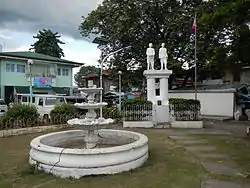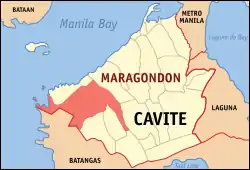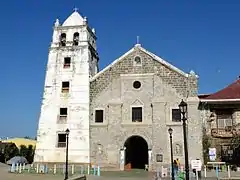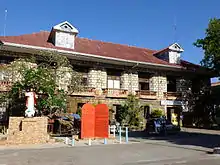Maragondon
Maragondon, officially the Municipality of Maragondon (Tagalog: Bayan ng Maragondon), is a 3rd class municipality in the province of Cavite, Philippines. According to the 2015 census, it has a population of 37,720 people. [3] The town is famous for its bamboo crafts, Mounts Palay-Palay–Mataas-na-Gulod Protected Landscape which includes Mount Pico de Loro, and various ancestral houses and structures important to Philippine history and culture such as Maragondon Church and the execution site and trial house of national hero Andres Bonifacio.[5][6]
Maragondon | |
|---|---|
| Municipality of Maragondon | |
 Municipal plaza | |
| Nickname(s): Historic Town & Wildlife Sanctuary | |
 Map of Cavite with Maragondon highlighted | |
OpenStreetMap 
| |
.svg.png.webp) Maragondon Location within the Philippines | |
| Coordinates: 14°16′N 120°44′E | |
| Country | |
| Region | Calabarzon (Region IV-A) |
| Province | Cavite |
| District | 8th District |
| Founded | 1727 |
| Barangays | 27 (see Barangays) |
| Government | |
| • Type | Sangguniang Bayan |
| • Mayor | Reynaldo A. Rillo (NUP) |
| • Vice Mayor | Alfredo A. Bersabe (PDPLBN) |
| • Representative | Abraham N. Tolentino |
| • Electorate | 29,221 voters (2019) |
| Area | |
| • Total | 164.61 km2 (63.56 sq mi) |
| Elevation | 77 m (253 ft) |
| Population | |
| • Total | 37,720 |
| • Density | 230/km2 (590/sq mi) |
| • Households | 8,201 |
| Economy | |
| • Income class | 3rd municipal income class |
| • Poverty incidence | 13.8% (2015)[4] |
| • Revenue | ₱101,388,428.87 (2016) |
| Time zone | UTC+8 (PST) |
| ZIP code | 4112 |
| PSGC | |
| IDD : area code | +63 (0)46 |
| Climate type | tropical monsoon climate |
| Native languages | Tagalog |
| Major religions |
|
| Feast date | August 15 |
| Catholic diocese | Diocese of Imus |
| Patron saint | Our Lady of Assumption |
| Website | www |
Barangays
Maragondon is politically subdivided into 27 barangays. [2]
- Bucal 1
- Bucal 2
- Bucal 3A
- Bucal 3B
- Bucal 4A
- Bucal 4B
- Caingin Pob.
- Garita 1A
- Garita 1B
- Layong Mabilog
- Mabato
- Pantihan 1 (Balayungan)
- Pantihan 2
- Pantihan 3 (Pook na Munti)
- Pantihan 4 (Pulo ni Sara)
- Santa Mercedes (Patungan)
- Pinagsanhan A (Ibayo)
- Pinagsanhan B (Ibayo)
- Poblacion 1A
- Poblacion 1B
- Poblacion 2A
- Poblacion 2B
- San Miguel A (Caputatan)
- San Miguel B (Caputatan)
- Talipusngo
- Tulay Silangan (Mabacao)
- Tulay Kanluran (Mabacao)
History


.jpg.webp)
The name Maragondon is a Spanish approximation of the Tagalog word maragundong (madagundong) which means "having a rumbling or thunderous sound". This refers to the noise coming from the Kay Albaran river in the village of Capantayan. This was initially the place on which the town was to be built. However, due to the floods caused by the frequent overflowing of the river, the town was later relocated to its present site.
Incidentally, Maragondon has three foundation dates; namely, 1. ) 1611 when the Franciscan Fathers from Silang established their first visita or chapel; 2.) 1690, the Fundacion Ecclesiastica or founding of the regular parish by the Jesuits, dedicating it to Our Lady of the Assumption; 3.) 1727, the Fundacion Civil, when the original barrio of Maragondon was separated from Silang during the administration of the Recollects and converted into an independent municipality with Gregorio Silvestre as the first gobernadorcillo. Maragondon belonged to the corregimiento of Mariveles (now Bataan province) until 1754 when Spanish governor General Pedro Manuel de Arandia (1754 - 1759) abolished the politico - military administration and restored Maragondon to Cavite Province. Alongside Silang, the town's territory was very large during its early decades.

In the second half of the 19th century the towns of Ternate, Magallanes, Gen. Emilio Aguinaldo (formerly Bailen), Alfonso, and Naic were mere barangays of Maragondon. Ternate was the first town to attain full independence on March 31, 1857, under an agreement signed by Tomas de Leon, Felix Nigosa, Pablo de Leon, Florencio Nino Franco and Juan Ramos in behalf of the people of Ternate.
Furthermore, Bailen (now Gen. Aguinaldo) and Alfonso seceded from Maragondon in 1858. Naic then severed as a town in 1869. Magallanes was the last of the villages to attain independence, having been founded on July 15, 1879 under an agreement signed by Crisostomo Riel representing Maragondon, and by Isidro Bello and company representing Magallanes.
Local Officials
The following are the elected officials of the town elected last May 13, 2019 which serves until 2022:
| Position | Official |
|---|---|
| Mayor | Reynaldo A. Rillo (NUP) |
| Vice Mayor | Alfredo A. Bersabe (PDPLBN) |
| Sangguniang Bayan Members | Party |
|---|---|
| Ireneo C. Angeles | NUP |
| Angelita M. De Joya | Independent |
| Alexander Alan S. Angeles | NUP |
| Alexander V. Villanueva | NUP |
| Reciel P. Diño | PDPLBN |
| Bernardo P. Ilagan | NUP |
| Alberto C. Malimban | NUP |
| Emilio P. Digal | PDPLBN |
| ABC President | |
| Rommel A. Manalo | |
| SK Federation President | |
| Neil Frederick B. Magallanes |
Demographics
| Year | Pop. | ±% p.a. |
|---|---|---|
| 1903 | 7,191 | — |
| 1918 | 7,266 | +0.07% |
| 1939 | 9,449 | +1.26% |
| 1948 | 8,465 | −1.21% |
| 1960 | 9,994 | +1.39% |
| 1970 | 12,743 | +2.46% |
| 1975 | 14,785 | +3.03% |
| 1980 | 18,018 | +4.03% |
| 1990 | 22,814 | +2.39% |
| 1995 | 25,828 | +2.35% |
| 2000 | 31,227 | +4.15% |
| 2007 | 33,604 | +1.02% |
| 2010 | 35,289 | +1.80% |
| 2015 | 37,720 | +1.28% |
| Source: Philippine Statistics Authority [3] [7] [8][9] | ||
In the 2015 census, the population of Maragondon was 37,720 people, [3] with a density of 230 inhabitants per square kilometre or 600 inhabitants per square mile.
Images
 Our Lady of the Assumption Parish Church
Our Lady of the Assumption Parish Church Welcome arch
Welcome arch Barangay Poblacion 1-B
Barangay Poblacion 1-B Public market
Public market Bonifacio Trial House
Bonifacio Trial House Mt. Pico De Loro Monolith
Mt. Pico De Loro Monolith Silyang Bato of Mt. Marami
Silyang Bato of Mt. Marami
References
- Municipality of Maragondon | (DILG)
- "Province: Cavite". PSGC Interactive. Quezon City, Philippines: Philippine Statistics Authority. Retrieved 12 November 2016.
- Census of Population (2015). "Region IV-A (Calabarzon)". Total Population by Province, City, Municipality and Barangay. PSA. Retrieved 20 June 2016.
- "PSA releases the 2015 Municipal and City Level Poverty Estimates". Quezon City, Philippines. Retrieved 1 January 2020.
- "The Official Website of the Municipality of Maragondon - Home". maragondon-official.cavite.gov.ph.
- Census of Population and Housing (2010). "Region IV-A (Calabarzon)". Total Population by Province, City, Municipality and Barangay. NSO. Retrieved 29 June 2016.
- Censuses of Population (1903–2007). "Region IV-A (Calabarzon)". Table 1. Population Enumerated in Various Censuses by Province/Highly Urbanized City: 1903 to 2007. NSO.
- "Province of Cavite". Municipality Population Data. Local Water Utilities Administration Research Division. Retrieved 17 December 2016.
External links
| Wikimedia Commons has media related to Maragondon, Cavite. |